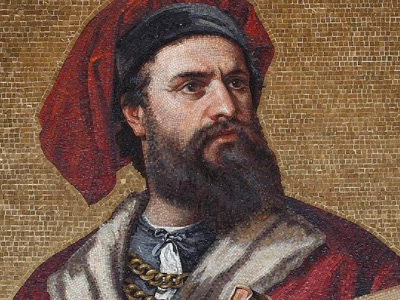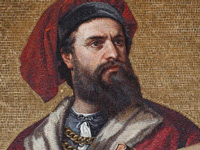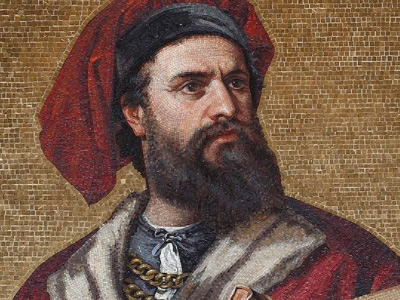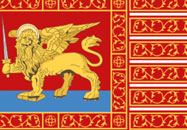Marco Polo (1254-1324)

Genoese Captivity and Later Life
Marco Polo returned to Venice in 1295 with his fortune converted into gemstones. At this time, Venice was at war with the Republic of Genoa. Polo armed a galley equipped with a trebuchet to join the war. He was probably caught by Genoans in a skirmish in 1296, off the Anatolian coast between Adana and the Gulf of Alexandretta and not during the battle of Curzola (September 1298), off the Dalmatian coast. The latter claim is due to a later tradition (16th Century) recorded by Giovanni Battista Ramusio.
He spent several months of his imprisonment dictating a detailed account of his travels to a fellow inmate, Rustichello da Pisa, who incorporated tales of his own as well as other collected anecdotes and current affairs from China. The book soon spread throughout Europe in manuscript form, and became known as The Travels of Marco Polo. It depicts the Polos' journeys throughout Asia, giving Europeans their first comprehensive look into the inner workings of the Far East, including China, India, and Japan.

These books are available for download with Apple Books on your Mac or iOS device
Polo was finally released from captivity in August 1299, and returned home to Venice, where his father and uncle in the meantime had purchased a large palazzo in the zone named contrada San Giovanni Crisostomo (Corte del Milion). For such a venture, the Polo family probably invested profits from trading, and even many gemstones they brought from the East. The company continued its activities and Marco soon became a wealthy merchant. Marco and his uncle Maffeo financed other expeditions, but likely never left Venetian provinces, nor returned to the Silk Road and Asia. Sometime before 1300, his father Niccolò died. In 1300, he married Donata Badoèr, the daughter of Vitale Badoèr, a merchant. They had three daughters, Fantina (married Marco Bragadin), Bellela (married Bertuccio Querini), and Moreta.
In 1305 he is mentioned in a Venetian document among local sea captains regarding the payment of taxes. His relation with a certain Marco Polo, who in 1300 was mentioned with riots against the aristocratic government, and escaped the death penalty, as well as riots from 1310 led by Bajamonte Tiepolo (by mother side grandson of Trogir count Stjepko Šubić) and Marco Querini, among whose rebels were Jacobello and Francesco Polo from another family branch, is unclear. Polo is clearly mentioned again after 1305 in Maffeo's testament from 1309–1310, in a 1319 document according to which he became owner of some estates of his deceased father, and in 1321, when he bought part of the family property of his wife Donata.
HISTORY

RESOURCES
This article uses material from the Wikipedia article "Marco Polo (1254-1324)", which is released under the Creative Commons Attribution-Share-Alike License 3.0.
© Stories Preschool. All Rights Reserved.









